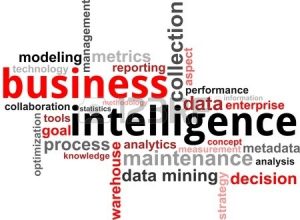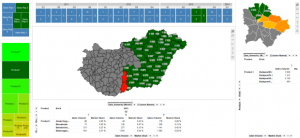New Generation BI Tools in Corporate Management
 Business Intelligence is a relatively new area of corporate IT. Very concise, it’s aim is to make company data understandable even for those users who are not really into IT (e.g. analysts, managers). Before the spread of BI, revealing relevant information required a great knowledge of databases and metadata. If data were derived from a number of core systems, beyond programming skills, one had to know how to link and match them. And if they wanted to receive them on a regular basis (e.g. monthly), they would probably have to invest in a small development project.
Business Intelligence is a relatively new area of corporate IT. Very concise, it’s aim is to make company data understandable even for those users who are not really into IT (e.g. analysts, managers). Before the spread of BI, revealing relevant information required a great knowledge of databases and metadata. If data were derived from a number of core systems, beyond programming skills, one had to know how to link and match them. And if they wanted to receive them on a regular basis (e.g. monthly), they would probably have to invest in a small development project.
Classic BI tools solved these problems: they automatically collected, integrated and made the user-requested data easily accessible on a constant frequency (even daily). However, they still couldn’t handle the problem of  quickly changing user needs. Creating a smaller data mart could last for several months – sometimes even for half a year, while the configuration of a data warehouse consisting of multiple data marts that served a number of areas of the company could take for years. By the time a solution was completed, it was almost certain that it required some modification. At best because the user no longer needed the same thing as at designing, at worst because the whole solution became obsolete.
quickly changing user needs. Creating a smaller data mart could last for several months – sometimes even for half a year, while the configuration of a data warehouse consisting of multiple data marts that served a number of areas of the company could take for years. By the time a solution was completed, it was almost certain that it required some modification. At best because the user no longer needed the same thing as at designing, at worst because the whole solution became obsolete.
By contrast, the new generation BI tools – such as Spotfire, Tableau or Power BI – can handle these problems completing the classic BI solutions. The strength of these software is that they support the iterative, agile development principles: new solutions can be created quickly and easily and they can be modified with similar simplicity based on feedbacks. It is very common for users to come up with new ideas after receiving a solution or to face the limits of their original concept. With these software such situations can be handled easily, with short deadlines, often on the spot.
A Felicitous Usage: Sales Support
 Of course, both Tableau and Spotfire support the purely web and mobile usage, so your colleagues can access the required information also outside the office. Furthermore, usually a tablet is enough for your sales representatives to inform their clients. This way all the information necessary for the attendance is available in a properly prepared and up-to-date format, so you co-workers can represent your company in a modern, elegant and cost-efficient way.
Of course, both Tableau and Spotfire support the purely web and mobile usage, so your colleagues can access the required information also outside the office. Furthermore, usually a tablet is enough for your sales representatives to inform their clients. This way all the information necessary for the attendance is available in a properly prepared and up-to-date format, so you co-workers can represent your company in a modern, elegant and cost-efficient way.
Thinking further, based on data from visits, complemented by a complete market or competitor data for a particular product or product group, group and region leaders can keep track of their  teams performance on the basis of up-to-date information. It’s easy to identify those colleagues who perform under expectations, those products that sell more or worse than expected, or those areas that has some outstanding indexes from a point of view. All these mentioned BI tools assist these statements with easily understandable, interactive, map-supported visualizations. With the help of these dynamic and interactive solutions problems and their components can be quickly identified on the base level.
teams performance on the basis of up-to-date information. It’s easy to identify those colleagues who perform under expectations, those products that sell more or worse than expected, or those areas that has some outstanding indexes from a point of view. All these mentioned BI tools assist these statements with easily understandable, interactive, map-supported visualizations. With the help of these dynamic and interactive solutions problems and their components can be quickly identified on the base level.
 Of course, as with any device in life, it is also true that expertise is necessary to produce maximum value. At the same time, user support, instant response and intuitive manageability were the key aspects in case of both these BI tools. An analyst with strong excel skills can create sterling reports and dashboards after a few days of training, while someone with SQL knowledge can compose even complete data integration solutions with them.
Of course, as with any device in life, it is also true that expertise is necessary to produce maximum value. At the same time, user support, instant response and intuitive manageability were the key aspects in case of both these BI tools. An analyst with strong excel skills can create sterling reports and dashboards after a few days of training, while someone with SQL knowledge can compose even complete data integration solutions with them.

